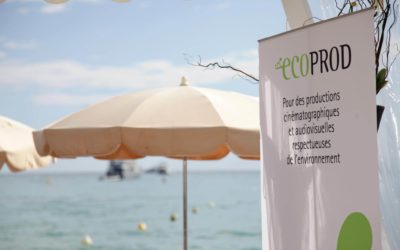Michel Barthélémy, head decorator
Michel Barthélémy, head decorator tells us a little more about EcoDéco.
On the occasion of the Production Forum, where a 100% eco-responsible set was presented, Michel Barthélémy, head decorator and member of the ADC – EcoDeco association, talks to us about the new challenges of this profession.
Why did you have the idea of highlighting this eco-responsible set at the Production Forum ?
This year, we wanted to focus on the environmental theme in our profession. So we designed a stand with several objectives. First of all, to raise awareness, to talk about our subject and to tell ourselves that we really should take care of it, that we have to have daily thoughts and actions with industrialists on these specific problems. Because our problems are those of industry, but since we, set designers, are moving very fast, we are building, using and dumping, we can see the full extent of this problem at an accelerated pace. So with this stand, we are showing that sustainable development is a complicated issue in this profession because there are a lot of intersecting axes.
First of all, we have to look at the materials we use, the history of the materials. We have to find more virtuous materials. This move towards eco-design means that we must first use bio-sourced materials, among conventional materials, either improve them by managing to remove toxic components, anything that is a bit petro-sourced, or innovate and find new materials. So there is innovation in the industry, with bioplastics, for example, with corn starch, with potato starch, with wheat. And we have to develop these kinds of products at an industrial level and see what problems they can cause. We must also find a way to be more modest in the consumption of materials. We have to consume as little as possible, so eco-design sets that don’t use too many materials. It is then necessary to be concerned, from the moment of the construction, of the dismantling phase of the sets where we will try to move more towards deconstruction in order to really be able to obtain as little waste as possible, in the dumpster, buried or incinerated. The elements of the sets, the different products that are built must be recyclable or reusable.
We are going to look for old techniques that have been abandoned because of profitability problems. In the 80s, we abandoned systems that were relatively virtuous, where we reused wood panels, called décor sheets, which have several lives, in favour of consuming materials, because it’s a commercial chain, everyone has a margin at each stage: between transport, delivery to the producers, arrival at the studio and in our hands. It was also linked to storage problems and also linked to labour costs. Because the panels that we recycled and reused required a lot of people to handle, store, and put away. These forgotten good practices must therefore be rediscovered, even if in a different form, i.e. not necessarily inside the studios, but outside, at service providers, in recycling and resource centres, which set up reuse circuits. But in any case, there also needs to be a kind of voluntary work on the part of the manufacturers.
We are also interested on this stand in the manufacture of sheets with the possibility of reuse but also in the treatment of water polluted by paint because we are not always in the ideal conditions of a studio equipped with paint reprocessing.
We can see that this touches many issues at the same time, sometimes even outside the film industry itself…
The problems are somewhat complex because we need answers from engineers, economists, institutions, our industry and our trades to develop the creative space of set construction in a more virtuous way. The idea is obviously to remain creative, not to punish oneself, to be innovative and to give pride of place to the decorative arts professions. That’s also what we’re showing on this stand, because there are some beautiful elements, such as a 3D printer. So these are the innovative products. We showed products printed with bioplastics, which are mixtures of hemp fibres and cornstarch plastic. There are mixtures of bioplastics of different qualities. This shows that we can also be in the world of the 21st century but with bio-sourced products. So that’s the direction we have to take, but it’s going to be more complex than that. We realize at each stage of reflection that we must find less worse solutions, that there are daily actions to be taken. We also plan to set up training and communication modules in schools of decorative arts and cinema, so that students, our future colleagues, will be a little better equipped to reflect on the subject.
So this is the goal of the EcoDéco collective ?
It is a collective that is common to both associations : ADC, the Association des Décorateurs de Cinéma and MAD, the Métiers Associés aux Décors. People who don’t belong to either of these associations but who are interested in this theme are also members of EcoDéco. There is nevertheless an ecologist who sleeps in each one of us. And collectively, we will have more strength than each of us in our own corner. We can share practices, good finds, good strings, it’s really a collective and voluntary work.
For the moment EcoDéco is a working group of our two associations in France. Quite lively and quite active, with a certain number of working groups, on our working conditions, our work contracts. This year, we have about a dozen of them and there is this theme of eco-responsibility which is salient because obviously it also talks about our working conditions, hygiene and safety at work. It is necessarily linked, a green planet works with our green lungs.
Autres articles
Ecoprod pour des tournages écoresponsables
Comme chaque année, le collectif Ecoprod exposera au Salon des Tournages et...
Les 20 ans de l’Industrie du Rêve
Pour ses 20 ans d’existence, Paris Images Cinéma – L’industrie du rêve...



